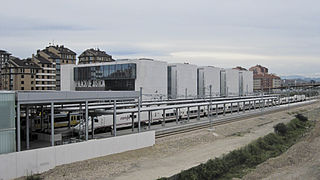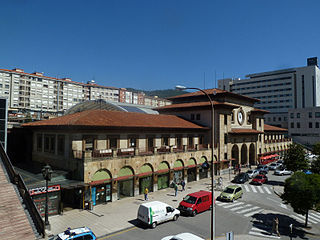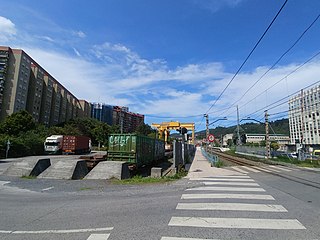
Commuter rail, or suburban rail, is a passenger rail transport service that primarily operates within a metropolitan area, connecting commuters to a central city from adjacent suburbs or commuter towns. Commuter rail systems are considered heavy rail, using electric or diesel trains. Distance charges or zone pricing may be used.

Transport in Spain is characterised by a network of roads, railways, trams, air routes, and ports. Its geographic location makes it an important link between Europe, Africa, and the Americas. Major forms of transit generally radiate from the capital, Madrid, located in the centre of the country, to link with the capitals of the autonomous communities.

Renfe Cercanías AM, formerly known as Renfe Feve, is a division of state-owned Spanish railway company Renfe Operadora. It operates most of Spain's 1,250 km (777 mi) of metre-gauge railway. This division of Renfe was previously a stand-alone company named FEVE. On 31 December 2012, the Spanish government simplified the organization of state-owned railway companies by merging FEVE into Renfe and Adif. The rolling stock and the brand FEVE were transferred to Renfe, while the infrastructure was transferred to Adif.

Renfe, officially Renfe-Operadora, is Spain's national state-owned railway company.

Rail transport in Spain operates on four rail gauges and services are operated by a variety of private and public operators. Total railway length in 2020 was 15,489 km. The Spanish high-speed rail network is the longest HSR network in Europe with 3,966 km and the second longest in the world, after China's.

Ferrocarrils de la Generalitat de Catalunya, or FGC, is a railway company which operates several unconnected lines in Catalonia, Spain.

The Bilbao metro is a rapid transit system serving the city of Bilbao and the region of Greater Bilbao. Lines 1 and 2 have a "Y" shape, as they transit both banks of the river Ibaizabal and then combine to form one line that ends in the south of Bilbao. Line 3 has a "V" shape connecting the municipality of Etxebarri with the Bilbao neighbourhood of Matiko; the apex of the "V" is Zazpikaleak/Casco Viejo station, where all three current lines meet. The metro is connected with the Bilbao tram, Bilboko Aldiriak, Euskotren Trena, Feve, Renfe long-distance trains, and Bilbao's bus station. All three lines use metre gauge.

The Abando Indalecio Prieto railway station, usually known simply as Bilbao-Abando and previously known as Estación del Norte is a terminal railway station in Bilbao, Basque Country (Spain). The name comes from Abando, the district in which the station is located, and Indalecio Prieto, who was Minister of Public Works during the Second Spanish Republic. The station serves as the terminus station for several long and medium distance services operated by Renfe as well as commuter rail services within the Bilbao metropolitan area operated by Cercanías. The station has direct access to Metro Bilbao and to the tram, as well as many local and regional bus lines. The railway station Bilbao-Concordia, operated by Renfe Feve is located in close proximity. After the construction of the high-speed line Basque Y is finished, Bilbao-Abando will serve as the western terminus, which will involve the creation of a completely new station replacing the current one.

Zazpikaleak/Casco Viejo – Zazpikaleak and Casco Viejo – is a railway station in Bilbao, Basque Country, Spain. It is located in the historical neighborhood of Casco Viejo, in the district of Ibaiondo. It links the Bilbao metro rapid transit services with the Euskotren Trena commuter rail network. It is the main railway hub for trips between the metropolitan underground network and the railway services to Eibar, Gernika, Bermeo and San Sebastián as well as the Txorierri valley. The original metro station opened on 11 November 1995, and on 8 April 2017 in its current form.

ADIF is a Spanish state-owned railway infrastructure manager. This state owned company reports to the Ministry of Transport and Sustainable Mobility. ADIF is charged with the management of most of Spain's railway infrastructure, that is the track, signaling and stations. It was formed in 2005 in response to European Union requirements to separate the natural monopoly of infrastructure management from the competitive operations of running train services. It is the legal successor of Renfe, Feve, and GIF.

Gijón Railway Station, also known as Gijón Sanz Crespo, is the main railway station of Gijón, Spain. Since 2011 it is located in Sanz Crespo street due to the works for the Metrotrén Asturias project. It is the terminus for Alvia services from Madrid, Alicante, León, Valladolid and Barcelona, as well as Intercity and Media Distancia services from Madrid, Valladolid and León. It is also the last destination for four Cercanías commuter railway lines.

In Spain there is an extensive 1,250 km (780 mi) system of 1,000 mmmetre gauge railways. The majority of these railways was historically operated by FEVE,. Created in 1965 FEVE started absorbing numerous private-owned narrow-gauge railways. From 1978 onwards, with the introduction of regionalisation devolution under the new Spanish constitution, FEVE began transferring responsibility for a number of its operations to the new regional governments. On 31 December 2012 the company disappeared due to the merger of the narrow-gauge network FEVE and the broad-gauge network RENFE.
Traditionally, the gauge of the national railway in Spain, now managed by Adif, is 1,668 mm, known as Iberian gauge. This gauge was decided upon by a Parliamentary committee, after a report known as the Informe Subercase in 1844. Spain has 11,791 km of track with this gauge.

Oviedo railway station is the main station in the Spanish city of Oviedo, capital of the province of Asturias. It opened in 1874 and was reconstructed after the Spanish Civil War.
Metrotrén Asturias is a project to enhance the Cercanías Asturias commuter rail in Spanish autonomous community of Asturias, primarily by way of an underground tunnel through the city of Gijón.

The Spanish city of Bilbao contains a dense urban rail network served by multiple operators, track gauges and types. It is one of a very small number of cities that have both narrow and broad gauge railways without any standard gauge railways.

The Bilbao-Concordia railway station, also known as La Concordia Station, and formerly and colloquially known as Santander Station, is a terminal railway station in Bilbao, Basque Country (Spain). The station was opened in 1902 and currently serves as the terminus station for several narrow-gauge regional and metropolitan railway services operated by Renfe Feve, a division of the state-owned Spanish railway company Renfe. The Bilbao-Abando railway station, also operated by Renfe and that offers medium and long-distance services is located in close proximity.

San Sebastián railway station, also known as Donostia-San Sebastián or Estación del Norte is the main railway station of the Spanish city of San Sebastián, Basque Country. It served over 2 million passengers in 2018.

Ferrocarriles Españoles de Vía Estrecha (FEVE), officially registered as Ferrocarriles de Vía Estrecha and known in its last years by the brand name Feve, was a Spanish public railway operator, founded in 1965, in charge of operating the national narrow-gauge network, whose management passed to the State after the extinction of the original owner companies. The entity depended on the Ministry of Development, being the second Spanish company in its sector, in terms of importance, after the also extinct RENFE. FEVE came to operate on a railway network of 1250 km of tracks.

The Ariz–Basurto line is a short single-track unelectrified railway line in Biscay, Basque Country, Spain. Owned by Euskal Trenbide Sarea, it connects the Basque narrow-gauge railway network with the Santander–Bilbao line. It is used for freight transport.


















